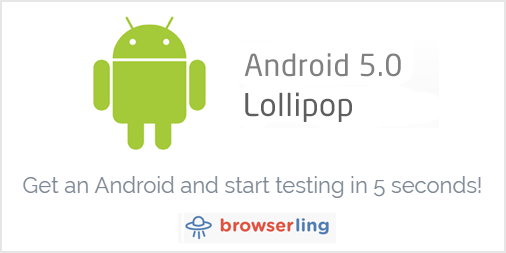Posted by on November 25, 2014
We just launched Android 5.0 Lollipop at Browserling. You can now cross-browser test your webapps and websites in Android 5.0.

We've also added Android 5.0 to our unique browser scheme. If you've a developer plan, you can access Android 5.0 through this URL in a second:
https://www.browserling.com/browse/android/5.0/http://www.digg.com
This will load digg.com on Android 5.0.
Or you can try Android 5.0, or any other version through our widget:
Android 5.0 Lollipop adds the following new features:
- Lock screen provides shortcuts to application and notification settings.
- Audio input and output through USB devices.
- Updated emoji.
- Support for print previews.
- Recent activities screen with tasks instead of applications, up to a configured maximum of tasks per application.
- A flashlight-style application is included, working on supported devices with a camera flash.
- Addition of 15 new languages: Basque, Bengali, Burmese, Chinese (Hong Kong), Galician, Icelandic, Kannada, Kyrgyz, Macedonian, Malayalam, Marathi, Nepali, Sinhala, Tamil and Telugu.
- Project Volta, for battery life improvements.
- Tap and Go allows users to quickly migrate to a new Android device, using NFC and Bluetooth to transfer Google Account details, configuration settings, user data and installed applications.
- Vector drawables, which scale without losing definition.
- User-customizable priorities for application notifications.
- Android Runtime (ART) with ahead-of-time (AOT) compilation and improved garbage collection (GC), replacing Dalvik that combines bytecode interpretation with trace-based just-in-time (JIT) compilation.
- WebViews receive updates independently through Google Play for security reasons, instead of relying on system-wide vendor updates.
- Pinning of an application's screen for restricted user activity.
- OpenGL ES 3.1 and Android Extension Pack (AEP) on supported GPU configurations.
- Improved accessibility support (e.g. switch access support).
- Searches can be performed within the system settings for quicker access to particular settings.
- Support for 64-bit CPUs.
- Third-party applications regain the ability to read and modify data located anywhere on external storage, such as on SD cards.
- Refreshed notification tray and quick settings pull-down.
- SELinux in enforcing mode for all domains.
- Recently used applications are remembered even after restarting the device.
- Guest logins and multiple user accounts are available on more devices, such as phones.
- Refreshed lock screen, no longer supporting widgets.
- Block-based over-the-air (OTA) updates for new devices.
- Smart lock feature.
- Material design, bringing a restyled user interface.
Happy cross-browser testing in Androids!
Email this blog post to your friends or yourself!
Try Browserling!
Enter a URL to test, choose platform, browser and version, and you'll get a live interactive browser in 5 seconds!



 Subscribe to updates!
Subscribe to updates!
 BizSpark
BizSpark